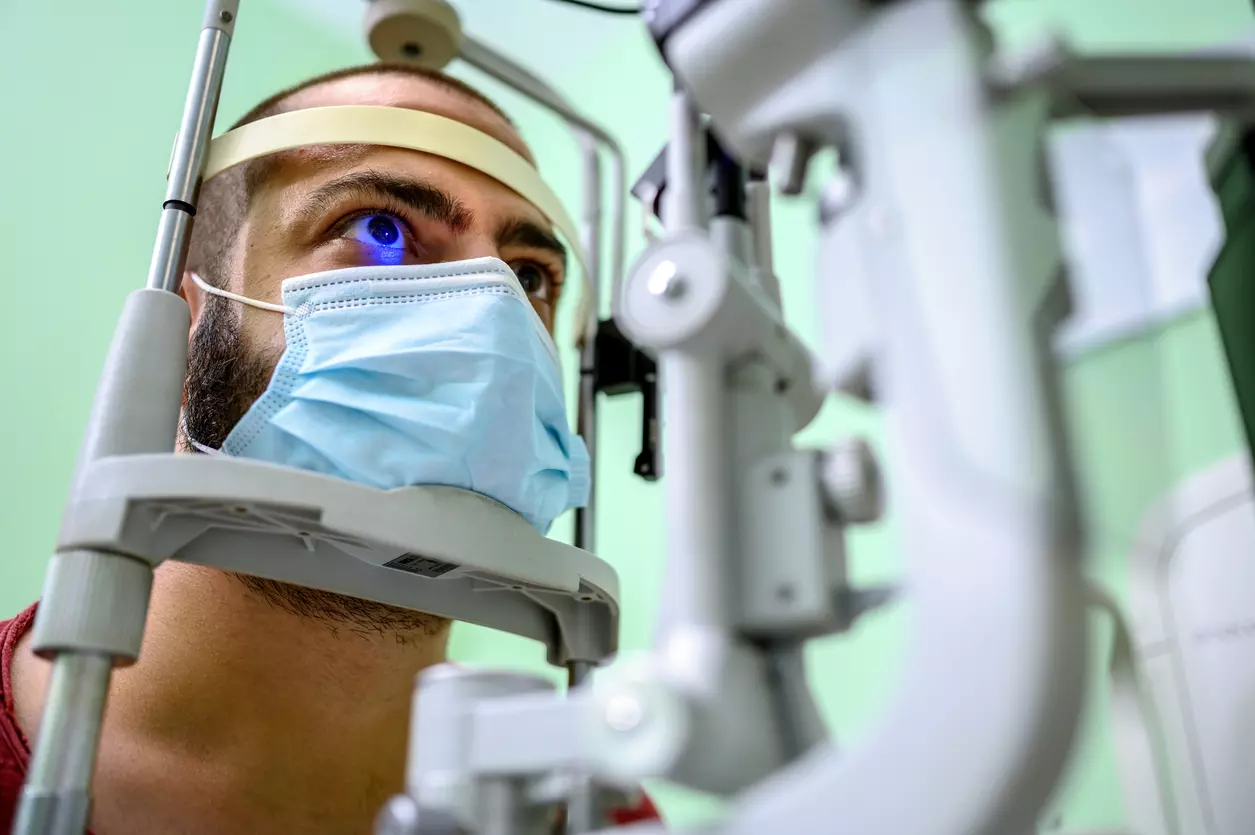
An ophthalmologist examining young man's eyesight with optical instrument. Representational image: iStock
Gut bacteria-devastating eye disease link: New study finds interesting facts
The study suggests that mutation in a particular gene leads to the weakening of the defensive barriers in the eyes thus allowing some gut bacteria to reach there.

Can bacteria in our gut travel up to the eyes, enter inside it, and cause severe damage with devastating consequences like blindness? Well, it may be the case as researchers have revealed in a recent study. The new findings are thought to pave a new way for treating such serious eye diseases which have been long thought to be purely genetic.
The study has been published recently in the journal Cell led by a team of researchers from Zhongsan Opthalmic Centre, Sun Yat-sen University, China. The study suggests that mutation in a particular gene leads to the weakening of the defensive barriers in the eyes thus allowing some gut bacteria to reach there. Then the question is how could bacteria travel from the gut to the eyes. Well, the answer again is mutation in a particular gene.
Impact of mutation in CRB1 gene
The team of researchers was investigating the impact of mutation in a gene known as the Crumbs homolog 1 or CRB1 gene. This particular gene is known to be expressed in the retina of the eye. The retina is the part situated at the back of the eye which is comprised of cells that capture the light particles or the photons that enter the eye. It is the retina that, after capturing the light particles, transmits signals to the brain (the visual cortex part) via neuronal pathways. This signaling is a complicated process and provides us vision. The retina is protected by the blood-retina barrier which regulates what gets in and out of the eye. This protective barrier prevents outside objects from entering the retina. On the other hand, the CRB1 gene is involved in building the blood-retina barrier. The researchers found mutation in the CRB1 gene which weakens the protective barrier making it easy for bacteria to enter the eye.
Interestingly, the CRB1 gene is also involved in the integrity of the gut, the researchers found. The human gut or the GI (Gastro intestinal) tract comprises all major organs involved in digestion, starting from the mouth to the anus including the esophagus, stomach and intestine. Food taken through the mouth gets digested in a series of processes throughout the GI tract, nutrients and energy are absorbed and the waste is expelled out of the anus. The researchers identified that mutation in the CRB1 gene weakens the integrity of the lower GI tract. Importantly, in this lower portion, the regulation of what gets passed between the gut contents and the rest of the body takes place. The weakening of the GI tract induced by CRB1 mutation facilitates some bacteria to get out from the gut and translocate to the retina.
This induces the development of devastating eye diseases like LCA (Leber congenital amaurosis) and RP (retinitis pigmentosa). As an article on the research findings published in UCL (University College of London) News bulletin says, CRB1 gene is linked to 10 per cent of LCA cases and 7 per cent of RP cases worldwide. The article also says that inherited eye diseases are the leading cause of blindness in the UK among working-age people.
Mouse model
It is worth remembering here that mutation is a process where random changes in the DNA take place through various mechanisms. When we speak about mutation in any gene, we indicate the random changes in the DNA because a gene is a portion of the DNA. A gene is that part of the DNA that directs the production of a particular protein. Each and every gene directs the production of a particular protein. The mutations in genes can sometimes cause diseases.
The team of researchers studied a particular mutation in the CRB1 gene which they called Rd8 mutation in mouse model. They developed mice with CRB1 mutation and depleted levels of gut bacteria. These mice did not show any sign of weakening in the retina, but those mice undergoing similar tests with the normal level of gut flora showed weakening in the retina. Moreover, the mice having the mutant gene and eye problem when treated with antibiotics or anti-inflammatory drug showed reduced effects of the bacteria.
Professor Richard Lee, an ophthalmologist at University College London and a co-author of the study while speaking about the findings was quoted as saying in a statement — “Our findings could have huge implications for transforming treatment for CRB1-associated eye diseases. We hope to continue this research in clinical studies to confirm if this mechanism is indeed the cause of blindness in people, and whether treatments targeting bacteria could prevent blindness.”
'Keep your excitement in check'
Although excitement brews with the new findings, there are some caveats in it according to some other experts. Jeremy Kay, a neurobiologist at Duke University, USA, was quoted to have said in an article by Saima Sidik about the findings, and published in Nature — “Although the paper presents a “cool idea”, people with CRB1 mutations should keep their excitement in check. I’m very concerned that patients are going to read this and think they have an easy answer.”
Kay highlighted the fact that the CRB1 mutation-associated eye diseases develop fully in many years, while the study time frame is small to reflect that. This made Kay apprehensive about the applicability of the results directly to humans. Kay further said in Sidik’s article — “I don’t believe that they’ve shown that the bacteria really go to the eye extensively enough to do much of anything. And if gut bacteria are causing eye infections, you would assume (infections are) happening other places, as well, which is something that has not yet been observed in people with CRB1 mutations.”

